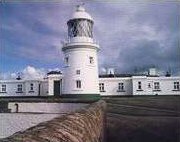
Pendeen Watch, Pendeen, TR19 7ED
Tel: (01736) 786900
Email: enquiries@trinityhouse.co.uk
Web: www.trinityhouse.co.uk/lighthouses-and-lightvessels/pendeen-lighthouse
For nearly 100 years Pendeen Lighthouse has been guiding passing vessels and warning of the dangerous waters around Pendeen Watch, less than two miles from Pendeen Village.
From Cape Cornwall the coast runs NE by E towards the Wra, or Three Stone Oar, off Pendeen. From here the inhospitable shore continues for a further eight miles or so to the Western entrance of St. Ives Bay, the principal feature here being the Gurnards Head, on which many ships have been wrecked.
Until 1891 maritime safety off Pendeen depended more on activity after a wreck rather than effective prevention, the "Admiralty Sailing Directions" for that year being only able to report a "Coastguard Station where a rocket apparatus is kept". The high cliffs along this sector of coastline prevented passing vessels from catching sight of either Trevose Head to the East or the Longships to the West; and so numbers of them, unable to ascertain their position, were lost, particularly on the groups of sunken and exposed rocks near Pendeen Watch. Trinity House became increasingly concerned about this state of affairs as the 19th century drew to its close, and decided to erect a lighthouse and fog signal at Pendeen. Designs for the building were prepared by Sir Thomas Matthews, the Trinity House Engineer, their construction being undertaken by Arthur Carkeek, of Redruth, with Messrs. Chance, of Birmingham supplying the lantern.
The 55 foot tower and buildings occupy a large area and before work could begin the cap of the Point had to be removed and the whole headland flattened, which necessitated the building of a huge retaining wall on the seaward side. By the beginning of 1900, Carkeek's men had only reached the half-way mark although the lantern makers were ready to go ahead. Work thereafter progressed more rapidly and the light was commissioned on September 26th 1900.
Within the tower itself are two rooms, one over the other, and above them the lantern which originally contained a five wick Argand lamp, to which oil was pumped from the room below. This lamp was replaced by an electric one in 1926 and the oil lamp is now on display at the Trinity House National Lighthouse Centre in Penzance. Around the lamp revolves an apparatus containing the lenses. This optic is very heavy, weighing 2.5 tons, but as it floats in a trough containing 0.75 of a ton of mercury it can be set in motion by the merest touch.
Pendeen Lighthouse was automated in 1995 with the keepers leaving the station on 3rd May. The original optic has been retained but a new lamp plinth with two position lamp changer has been installed along with an emergency light and a new fog signal with fog detector. The lighthouse is now monitored and controlled via a telemetry link from the Trinity House Operational Control Centre at Harwich.
One mile north of the village of Pendeen.
Opening Times3rd April - 29th September Free On-Site Parking Admission Charged |
Cape Cornwall Cornish Lighthouses Cornwall's Shipwrecks Morvah Pendeen St. Just The Coastal Footpath
Botallack Mine Levant Beam Engine Geevor Mine Gem and Jewellery Workshop Pendeen Pottery